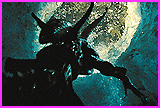A far greater challenge still awaited Blue Sky's team, however. For a 12-minute cat-and-mouse-style chase sequence, Blue Sky's animators took the alien where it's never gone before: swimming. "The alien actually chases Ripley (Sigourney Weaver), Call (Winona Rider) and others underwater, and our work is interspersed throughout," Kopelman reveals. "That's the majority of our work. Dealing with under water shooting and getting underwater reference presented tremendous challenges. It's quite a tense sequence."
Given the complexity of the job at hand, not all of the tension was on screen. While making the alien walk might have been demanding, getting the creature to swim was an even greater challenge. "We decided that it would propel itself with its tail," Kopelman says. "We patterned its movements on reference footage of sea iguanas. They have this crazy little swim where they tuck their legs under their bodies and use this really long tail to propel themselves. Creating the feeling that the alien was pushing itself forward with its tail was difficult, but it came off really well."
The next hurdle was making their CG alien appear to be underwater, as opposed to looking "pasted-in" over the water. Scollard recalls, "When we were shooting reference material of the suit, we found that things shot underwater don't look as if they're underwater live-action shots look like bad compositing. If the water is clear, the only clues that something is underwater are the movement, bubbles, and floating hair. Without those cues, things objects rarely look as if they're really underwater."
To more completely integrate the alien into those watery background plates, Blue Sky created interactive lighting tied into the radiant shafts of light filtering down from the surface of the water. "One of the most beautiful things in ocean documentaries is the shimmering light and shadows cast on whales by those beams of light," Kopelman says. "The guys over in our R&D department figured out a way to create that look digitally. We set up computer-generated lights in the same places where there were natural beams of light shooting through the water in the plates. When our CG alien swam through those real shafts of light, we had reflections shimmering on its dome, and its shadow was cast onto the floor. We also did a particle simulation of the air being exhaled by the actors. Our alien actually interacts with this field of bubbles, which helped make it feel like a real creature inside a 3-D environment."
The sequence climaxes when the alien makes a dramatic exit from its watery environs, leaping onto a ladder and pursuing its human prey up an elevator shaft. The startling effects shot, which ends on a full close-up of the alien as it scales the ladder, employed a clever combination of traditional and CG effects. "We attached a solid black rubber casting of the alien suit to a couple of cables, and launched it out of the water along the trajectory we wanted our digital alien to follow," Kopelman explains. "That practical effect created tons of bubbles and cavitation in the water; we then stuck our CG alien in the midst of all that turmoil, which worked incredibly well. As the alien climbed the ladder, we did a particle simulation to mimic the sparks falling down from the ceiling in the live-action plate, so all of those streamers cascaded down on the creature's elongated head and were reflected off its wet body."
Says Scollard, "The only CG aspect of that frame is the alien. We really matched what was happening in the live shot, so you see reflections from those sparks and explosions in its dome, as if it were really there. That's because our renderer, CGI Studio which was the initial basis for Blue Sky's success is the best ray-tracing outfit in the history of ray-tracing. There's a lot of intercutting between our alien and the man-in-the-suit creature; there are at least eight setups in the sequence, four with our CG character."
Destroying one of these mean-spirited marauders demanded another blend of live-action pyrotechnics and Blue Sky's digital alien. For a scene in which one of the humans launches a torpedo at an alien, the on-set effects team rigged up a life-size, waterbound wax alien full of explosives, guts and grisly chunks. "They detonated it and it went up in this huge, amazing fireball," Kopelman says gleefully. "There were lots of wax pieces, giant chunks of the alien, flying off. Next, we put a blank plate with no torpedo or alien at the head of our shot, added our alien swimming along, and then started up the live-action footage of the torpedo launching and cruising through the water. Then we removed the wax alien so that just the explosion remained, made some mattes, and mixed our CG alien in with that explosion, which really helped. Of course, there's a second CG alien that avoids the explosion and keeps swimming on!"
Alien Resurrection marks Blue Sky Studios' quantum leap from commercials and cult films to one of the biggest film franchises of all time. "It was exciting that our little company, tucked in Westchester, New York, was selected by 20th Century Fox to be part of a major movie legacy," Scollard says. "Like most animation/effects guys, we're fans of the Alien movies it's our Godfather series. We're totally psyched to be working on it."
